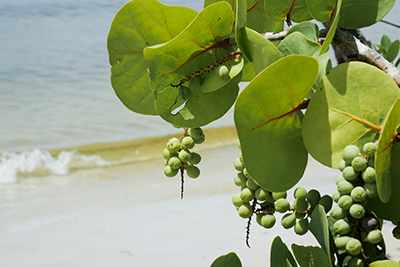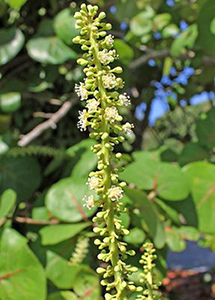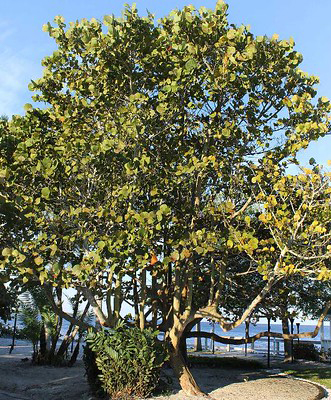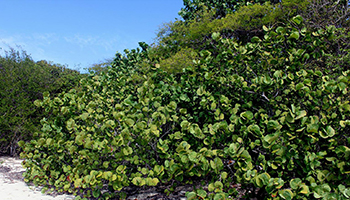Seagrape

Seagrape (Coccoloba uvifera) on a beach at San Carlos Bay, Florida. Credit: UF/IFAS
Seagrape takes its common name from its coastal home and the clusters of red, grape-like fruits it produces. Though not true grapes, these fruits are edible and the taste is often compared to muscadine grapes.
Seagrape is beautiful and tasty, but like our native mangrove, it is also protected. As part of a larger effort to preserve Florida's coastal ecological communities, the Department of Environmental Protection protects native salt-tolerant and endangered-plant communities. Florida law states that no person, firm, corporation, or governmental agency shall damage or cause to be damaged sand dunes or the vegetation growing on the dune system (subparagraph 161.053(2)(a), Florida Statutes).
What does this mean for Floridians? It means that seagrape growing along Florida's coast is off-limits. You cannot destroy or damage (or consume) these plants along the shoreline without a permit. If you are hoping to enjoy this classic Florida fruit, your best bet is to add it to your home landscape, away from the waterfront.
Characteristics

Seagrape flowers attract native pollinators. The fruit is attractive to birds and other wildlife. Credit: UF/IFAS
The natural range of seagrape (Coccoloba uvifera) covers the coastal areas of Central and South Florida, from USDA Hardiness Zones 10A-11. It has been reported as far north as zone 9A, but is sensitive to frost and freeze.
Seagrape can be grown as a shrub or tree, depending on its planting site and pruning. In its mature form it produces a symmetrical, moderately dense crown, 35 to 50 feet high and 20 to 30 feet across. With patience this shrub can be pruned into a hedge, screen, or windbreak. Seagrape can also be pruned into an attractive tree, exposing an interesting, twisted trunk. On shorelines it is often planted to help control dune erosion.
Seagrape leaves are round, wide, and evergreen. The younger growth is red, but foliage matures to a bright green with red veins. The flowers are small and cream-colored, blooming in long clusters. They usually bloom from spring to early summer, but can occur year-round. Fruit set occurs in mid-summer, and the immature fruits resemble green grapes on the vine. The clusters deepen to a red or purple color as they ripen in the fall.
As a landscape plant, seagrape has a lot going for it. It is a Florida native species. It grows in full sun or partial shade, and is very drought tolerant once established. It also tolerates salt spray and salty soils, making it a Florida-Friendly choice for beachfront homes. It requires very little maintenance beyond pruning to maintain the desired shape.
Before you add seagrape to your landscape, however, there are a few things to consider. Seagrape is sensitive to frost and freeze, and will benefit from protection when temperatures drop. The large leaves also mean it does not respond well to mechanical shearing; seagrape should be pruned by hand. Some homeowners also find that the large, slowly-decomposing leaves create litter that is annoying to remove.
Planting and Maintenance

Seagrape can be pruned into a tree, bush, hedge, windbreak, or ground cover. Credit: UF/IFAS
Plant seagrape in sandy, well-drained soil, preferably in full sun. Keep the young plant well-watered until it is established. It can be propagated by seeds or cuttings if you wish to expand the planting. Hand-pruning every couple of years is necessary to control its form.
While seagrape is largely disease free, there are two pests of note. The seagrape borer is a native moth that bores into twigs and small branches, killing them and the attached leaves. The damage is usually minor. There is also a nipple gall that raises red bumps on the upper surface of the leaves.
A note for gardeners hoping for fruits: seagrape is dioecious. This means that individual plants are either male or female. Fruiting occurs only on the female plant. To encourage pollination and fruit set you may need to install both a male and a female plant if there is no seagrape growing nearby. Seagrape fruits ripen in the fall and can be made into jelly or eaten raw.
For more information on seagrape, contact your county Extension office.
Also on Gardening Solutions

Seagrape is often used to control erosion in shoreline dunes. Credit: Whitney Cranshaw, Colorado State University, Bugwood.org

